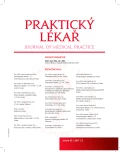-
Medical journals
- Career
Honey and health
Authors: V. Bencko 1; E. H. Myrvold 1; P. Šíma 2
Authors‘ workplace: Ústav hygieny a epidemiologie 1. lékařské fakulty UK v Praze Přednosta: prof. MUDr. Milan Tuček. CSc. 1; Mikrobiologický ústav, Akademie věd ČR v. v. i., Praha Ředitel: RNDr. Martin Bilej, DrSc. 2
Published in: Prakt. Lék. 2017; 97(5): 195-197
Category: Reviews
Overview
Honey has been used by humans since prehistory. It is the oldest known sweetener, and it also contains a number of health-promoting antibacterial, antifungal and antioxidant substances. It is traditionally used for skin care, and for its anti-inflammatory and immunostimulatory effects it is successfully applied not only in wound healing but also in the treatment of skin infections (dermatitis, acne etc). It also helps in the supportive treatment of gastrointestinal disorders (gastro-esopharyngeal disorders, peptic ulcers).
The issue of therapeutic use of honey is given increasing attention due to its antibacterial, immunostimulatory and antioxidant effects, especially in the context of wound healing. For the time being, however, the quality of most of the presented clinical references is low, lacking verified evidence of mechanisms for its therapeutic effects. However, it is promising, especially in the context of increasing antibiotic resistance, that many in vitro studies demonstrate the antimicrobial activity of honey, including a description of its mechanism of action.Keywords:
medicinal use of honey – antimicrobial effects – immunostimulation – wound healing – healing effects – antibiotic resistance
Sources
1. Eteraf-Oskouei T, Najafi M. Traditional and modern uses of natural honey in human diseases: a review. Iran J Basic Med Sci 2013; 16(6): 731–742.
2. Ajibola A, Chamunorwa JP, Erlwanger KH. Nutraceutical values of natural honey and its contribution to human health and wealth. Nutr Metab (Lond). 2012; 9 : 61. Published online 2012 Jun 20. doi:10.1186/1743-7075-9-61
3. Pimentel RB de Q, da Costa CA, Albuquerque PM, Junior SD. Antimicrobial activity and rutin identification of honey produced by the stingless bee Melipona compressipes manaosensis and commercial honey. BMC Complement Altern Med 2013; 13 : 151. Published online 2013 Jul 1. doi:10.1186/1472-6882-13-151
4. Wasfi R, Elkhatib WF, Khairalla AS. Effects of selected Egyptian honeys on the cellular ultrastructure and the gene expression profile of Escherichia coli. PLoS ONE 2016; 11(3): e0150984. doi:10.1371/journal.pone.0150984
5. Levinson W. Review of medical microbiology and immunology. 12th ed. New York: McGraw-Hill Medical 2012.
6. Carter DA, Blair SE, Cokcetin NN, et al. Therapeutic Manuka honey: no longer so alternative. Front Microbiol 2016; 7 : 569. Published online 2016 Apr 20. doi.org/10.3389/fmicb.2016.00569
7. Mavric E, Wittmann S, Barth G, Henle T. Identification and quantification of methylglyoxal as the dominant antibacterial constituent of Manuka (Leptospermum scoparium) honeys from New Zealand. Mol Nutr Food Res 2008; 52(4): 483–489. doi: 10.1002/mnfr.200700282
8. Hayashi, K, Fukushima, A, Hayashi-Nishino, M, Nishino, K. Effect of methylglyoxal on multidrug-resistant Pseudomonas aeruginosa. Front Microbiol 2014; 5 : 180. Published online 2014 Apr 17. http://doi.org/10.3389/fmicb.2014.00180
9. Kwakman PH, Te Velde AA, de Boer L, et al. Two major medicinal honeys have different mechanisms of bactericidal activity. PLoS ONE 2011; 6(3): e17709.
10. Estevinho L, Pereira AP, Moreira L, Dias LG, Pereira E. Antioxidant and antimicrobial effects of phenolic compounds extracts of northeast Portugal honey. Food Chem Toxicol 2008; 46(12): 3774–3779.
11. Lu J, Turnbull L, Burke CM, et al. Manuka-type honeys can eradicate biofilms produced by Staphylococcus aureus strains with different biofilm-forming abilities. Peer J 2014; (2): 326. Published online 2014 Mar 25. doi:10.7717/peerj.326
12. Liu M, Lu J, Müller P, et al. Antibiotic-specific differences in the response of Staphylococcus aureus to treatment with antimicrobials combined with manuka honey. Front Microbiol. 2015; 5 : 779. Published online 2015 Jan 27. doi:10.3389/fmicb.2014.00779
13. Shahzad A, Cohrs RJ. In vitro antiviral activity of honey against varicella zoster virus (VZV): A translational medicine study for potential remedy for shingles. Transl Biomed 2012; 3(2): 2.
14. Watanabe K, Rahmasari R, Matsunaga A, et al. Anti-influenza viral effects of honey in vitro: potent high activity of manuka honey. Arch Med Res 2014; 45(5): 359–365.
15. Brudzynski K, Sjaarda C. Antibacterial compounds of Canadian honeys target bacterial cell wall inducing phenotype changes, growth inhibition and cell lysis that resemble action of β-lactam antibiotics. PLoS ONE 2014; 9(9): e106967. doi:10.1371/journal.pone.0106967.
16. Molan P, Rhodes T. Honey: A biologic wound dressing. Wounds 2015; 27(6): 141–151.
17. Jull AB, Cullum N, Dumville JC, et al. Honey as a topical treatment for wounds. Cochrane Database Syst Rev 2008; (4): CD005083. doi:10.1002/14651858.CD005083.pub2
18. Dorne JLCM, Fink-Gremmels J. Human and animal health risk assessments of chemicals in the food chain: Comparative aspects and future perspectives. Toxicol Appl Pharmacol 2013; 270(3): 187–195.
19. Okuyan E, Uslu A, Ozan Levent M. Cardiac effects of „mad honey“: a case series. Clin Toxicol (Phila) 2010; 48 : 528–532.
20. Kromerová K, Bencko V. Súčasné trendy v procese hodnotenia rizika expozície cudzorodým látkam vrátane expozície z potravín. Hygiena 2017; 62 (2): 54–61.
Labels
General practitioner for children and adolescents General practitioner for adults
Article was published inGeneral Practitioner

2017 Issue 5-
All articles in this issue
- Honey and health
- Functional disorders of the musculoskeletal system
- Modern technology and its application in home-based rehabilitation
- Prostate cancer and secondary prevention in general practitioners’ offices
- Health literacy of seniors and its impact on health and the use of health services
- Selected problems in female patients with relapsing-remitting sclerosis multiplex
- European guide on good practices for Patient Blood Management
- General Practitioner
- Journal archive
- Current issue
- Online only
- About the journal
Most read in this issue- Functional disorders of the musculoskeletal system
- Selected problems in female patients with relapsing-remitting sclerosis multiplex
- Honey and health
- European guide on good practices for Patient Blood Management
Login#ADS_BOTTOM_SCRIPTS#Forgotten passwordEnter the email address that you registered with. We will send you instructions on how to set a new password.
- Career

